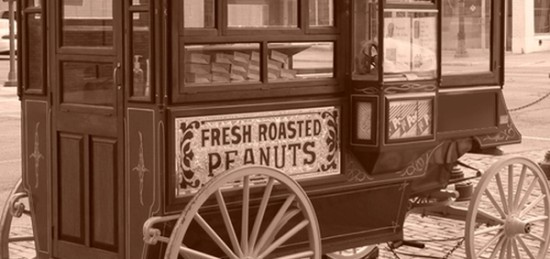- The history of peanuts is a journey from South America, to Asia, east across the Atlantic Ocean and back again to North America.
- Peanut butter was first introduced at the St. Louis World’s Fair in 1904 and became a source of delicious protein during the first two world wars.
The peanut plant probably originated in Peru or Brazil in South America. No fossil records prove this, but people in South America made pottery in the shape of peanuts or decorated jars with peanuts as far back as 3,500 years ago.
As early as 1500 B.C., the Incans of Peru used peanuts as sacrificial offerings and entombed them with their mummies to aid in the spirit life. Tribes in central Brazil also ground peanuts with maize to make a drink.
European explorers first discovered peanuts in Brazil. Peanuts were grown as far north as Mexico when the Spanish began their exploration of the new world. The explorers took peanuts back to Spain, and from there, traders and explorers spread them to Asia and Africa. Africans were the first people to introduce peanuts to North America beginning in the 1700s.
Records show that it wasn’t until the early 1800s that peanuts were grown as a commercial crop in the U.S. They were first grown in Virginia and used mainly for oil, food and as a cocoa substitute. At this time, peanuts were regarded as a food for livestock and the poor and were considered difficult to grow and harvest.
Peanut production steadily grew in the first half of the nineteenth century. Peanuts became prominent after the Civil War when Union soldiers found they liked them and took them home. Both armies subsisted on this food source high in protein.
Their popularity grew in the late 1800s when PT Barnum’s circus wagons traveled across the country and vendors called “hot roasted peanuts!” to the crowds. Soon street vendors began selling roasted peanuts from carts and peanuts also became popular at baseball games. While peanut production rose during this time, peanuts were still harvested by hand (learn more about the history of peanut harvesting here), leaving stems and trash in the peanuts. Thus, poor quality and lack of uniformity kept down the demand for peanuts.
Around 1900, labor-saving equipment was invented for planting, cultivating, harvesting and picking peanuts from the plants, as well as for shelling and cleaning the kernels. With these significant mechanical aids, demand for peanuts grew rapidly, especially for oil, roasted and salted nuts, peanut butter and candy.
In the early 1900s peanuts became a significant agricultural crop when the boll weevil threatened the South’s cotton crop. Following the suggestions of noted scientist Dr. George Washington Carver, peanuts served as an effective commercial crop and, for a time, rivaled the position of cotton in the South.
Who invented peanut butter?
There is evidence that ancient South American Incas were the first to grind peanuts to make peanut butter. In the U.S., Dr. John Harvey Kellogg (of cereal fame) invented a version of peanut butter in 1895. Then it is believed that a St. Louis physician may have developed a version of peanut butter as a protein substitute for his older patients who had poor teeth and couldn’t chew meat. Peanut butter was first introduced at the St. Louis World’s Fair in 1904.
Peanuts and peanut butter became an integral part of the Armed Forces rations in World Wars I and II. It is believed that the U.S. army popularized the peanut butter and jelly sandwich for sustenance during maneuvers in World War II.
Peanuts and Peanut Butter in America Today
Peanuts are the 12th most valuable cash crop grown in the U.S., with a farm value of over $1 billion, according to The American Peanut Council.
Unlike other countries, the prime market for U.S. peanuts is in edible consumption, so the marketing and production focus is in that direction.
Peanuts, peanut butter and peanut candy are some of the most popular products in the U.S. Americans eat more than 7.9 pounds of peanut products each year, worth more than $2 billion at the retail level.
Peanut butter accounts for about half of the U.S. edible use of peanuts — accounting for $850 million in retail sales each year. It is a popular sandwich spread, for children and adults, because it is both nutritious and economical.
The other half of U.S. consumption is divided equally between snack nuts and confectionery. Peanuts are eaten as snack nuts in many ways: roasted in shell, roasted kernels or in mixed nuts. Snack nuts are often salted, spiced or flavored with a variety of coatings.
Many of the top-selling confectionery products in the U.S. contain peanut and peanut butter. They are most popular in combination with chocolate. Peanuts and peanut butter also are used in a variety of cookies and baked goods. Peanut oil is considered a premium, high-quality cooking oil in the U.S., is able to withstand higher cooking temperature than many other oils and does not retain the flavor of foods cooked in it.
Sources:
